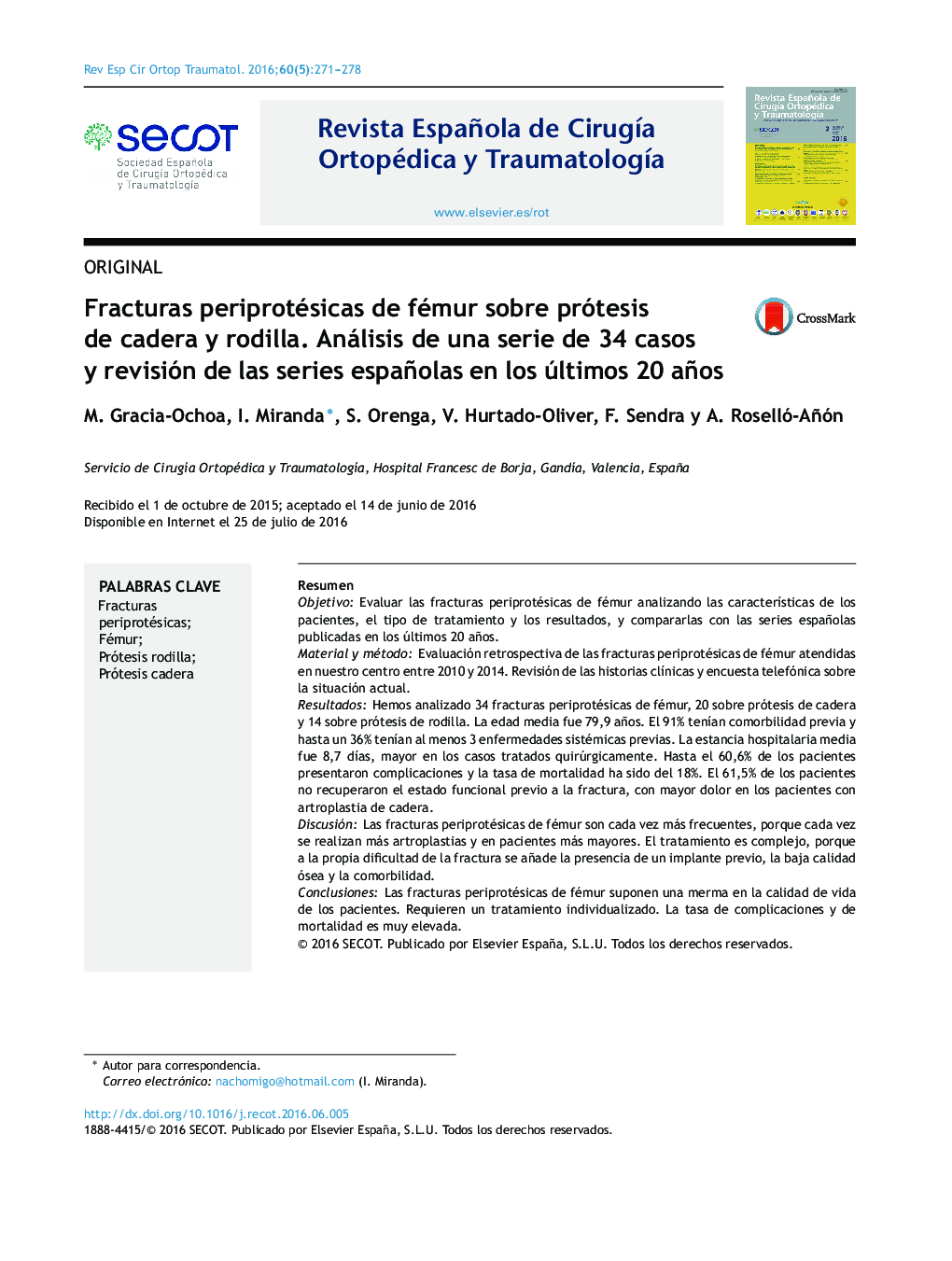| Article ID | Journal | Published Year | Pages | File Type |
|---|---|---|---|---|
| 4086137 | Revista Española de Cirugía Ortopédica y Traumatología | 2016 | 8 Pages |
ResumenObjetivoEvaluar las fracturas periprotésicas de fémur analizando las características de los pacientes, el tipo de tratamiento y los resultados, y compararlas con las series españolas publicadas en los últimos 20 años.Material y métodoEvaluación retrospectiva de las fracturas periprotésicas de fémur atendidas en nuestro centro entre 2010 y 2014. Revisión de las historias clínicas y encuesta telefónica sobre la situación actual.ResultadosHemos analizado 34 fracturas periprotésicas de fémur, 20 sobre prótesis de cadera y 14 sobre prótesis de rodilla. La edad media fue 79,9 años. El 91% tenían comorbilidad previa y hasta un 36% tenían al menos 3 enfermedades sistémicas previas. La estancia hospitalaria media fue 8,7 días, mayor en los casos tratados quirúrgicamente. Hasta el 60,6% de los pacientes presentaron complicaciones y la tasa de mortalidad ha sido del 18%. El 61,5% de los pacientes no recuperaron el estado funcional previo a la fractura, con mayor dolor en los pacientes con artroplastia de cadera.DiscusiónLas fracturas periprotésicas de fémur son cada vez más frecuentes, porque cada vez se realizan más artroplastias y en pacientes más mayores. El tratamiento es complejo, porque a la propia dificultad de la fractura se añade la presencia de un implante previo, la baja calidad ósea y la comorbilidad.ConclusionesLas fracturas periprotésicas de fémur suponen una merma en la calidad de vida de los pacientes. Requieren un tratamiento individualizado. La tasa de complicaciones y de mortalidad es muy elevada.
PurposeTo evaluate peri-prosthetic femoral fractures by analysing type of patient, treatment and outcomes, and to compare them with Spanish series published in the last 20 years.Material and methodsA retrospective review of the medical records of patients with peri-prosthetic femoral fractures treated in our hospital from 2010 to 2014, and telephone survey on the current status.ResultsA total of 34 peri-prosthetic femoral fractures were analysed, 20 in hip arthroplasty and 14 in knee arthroplasty. The mean age of the patients was 79.9 years, and 91% had previous comorbidity, with up to 36% having at least 3 prior systemic diseases. Mean hospital stay was 8.7 days, and was higher in surgically-treated than in conservative-treated patients. The majority (60.6%) of patients had complications, and mortality was 18%. Functional status was not regained in 61.5% of patients, and pain was higher in hip than in knee arthroplasty.DiscussionPeri-prosthetic femoral fractures are increasing in frequency. This is due to the increasing number of arthroplasties performed and also to the increasing age of these patients. Treatment of these fractures is complex because of the presence of an arthroplasty component, low bone quality, and comorbidity of the patients.ConclusionPeri-prosthetic femoral fractures impair quality of life. They need individualised treatment, and have frequent complications and mortality.
